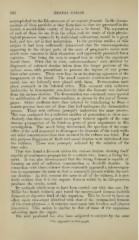Page 750 - My FlipBook
P. 750
760 DENTAL CARIES.
accomplished by the life-processes of an organic ferment. In the decom-
position of these particles as they from time to time are presented in the
mouth, a considerable variety of fungi are to be found. The separation
of each of these the one from the other, and the study of their physio-
logical processes separately by individual cultivations, would be a great
task, and was not at first undertaken. In the previous studies of this
subject it had been sufficiently determined that the micro-organisms
appearing in the deeper parts of the mass of progressive caries were
much more constant in their characters and apparently presented fewer
varieties. This being the case, it seemed best to study the organisms
found there. With this in view, culture-mediums^ were infected by
fragments of softened dentine taken from the deeper portions of the
carious mass, with precautions to prevent the ingress of any germs
from other sources. These were kept in an incubating apparatus at the
temperature of the blood. The usual controls (culture-mediums pre-
pared, but not infected) were placed with them. Fermentation took
place promptly in the infected tubes. This occurred with sufficient
uniformity to demonstrate conclusively that the ferment was derived
from the carious dentine. The fermentation was constantly accompanied
by acidification of the culture-medium, as shown by the use of litmus-
paper. Other mediums were then infected by transferring to them a
minute portion from one of those that had undergone the fermentative
process. These new cultures promptly underwent the" same process.
This was continued for a sufficient number of generations to show con-
clusively that there was present an organic ferment capable of the con-
tinuous propagation of its kind—a poini of great importance in this
investigation. This much being determined, the question of the capa-
bility of the acid generated to decompose the elements of the tooth with-
out other concentration than that attained in the culture was tried. For
this purpose fragments of fresh and sound dentine were introduced into
the cultures. These were promptly softened by the solution of the
lime salts.
Thus was found a ferment within the carious dentine showing itself
capable of continuous propagation in a certain line ; hence, a living fer-
ment. It was also demonstrated that this living ferment is capable of
forming an acid of sufficient concentration to decalcify dentine. In
connection with these cultures there constantly appeared a micro-organ-
ism in appearance the same as that so constantly present within the cari-
ous dentine. As this remains the same in all of the cultures, it is per-
fectly evident that it is the organic ferment which by its life-processes
produces the results stated.
By methods which seem to have been carried out with due care. Dr.
Miller has found, isolated, and tested the unorganized ferment (soluble
ferment) or digestive fluid of this organism. This he found to have an
effect upon cane-sugar identical with that of the unorganized ferment
of the yeast-plant— /. e. it converts cane-sugar into levulose and glucose
(dextrose). This action is similar to that of most of the organisms
subsisting upon the sugars.
The acid produced has also been subjected to analysis by the same
' See appendix to this paper.


